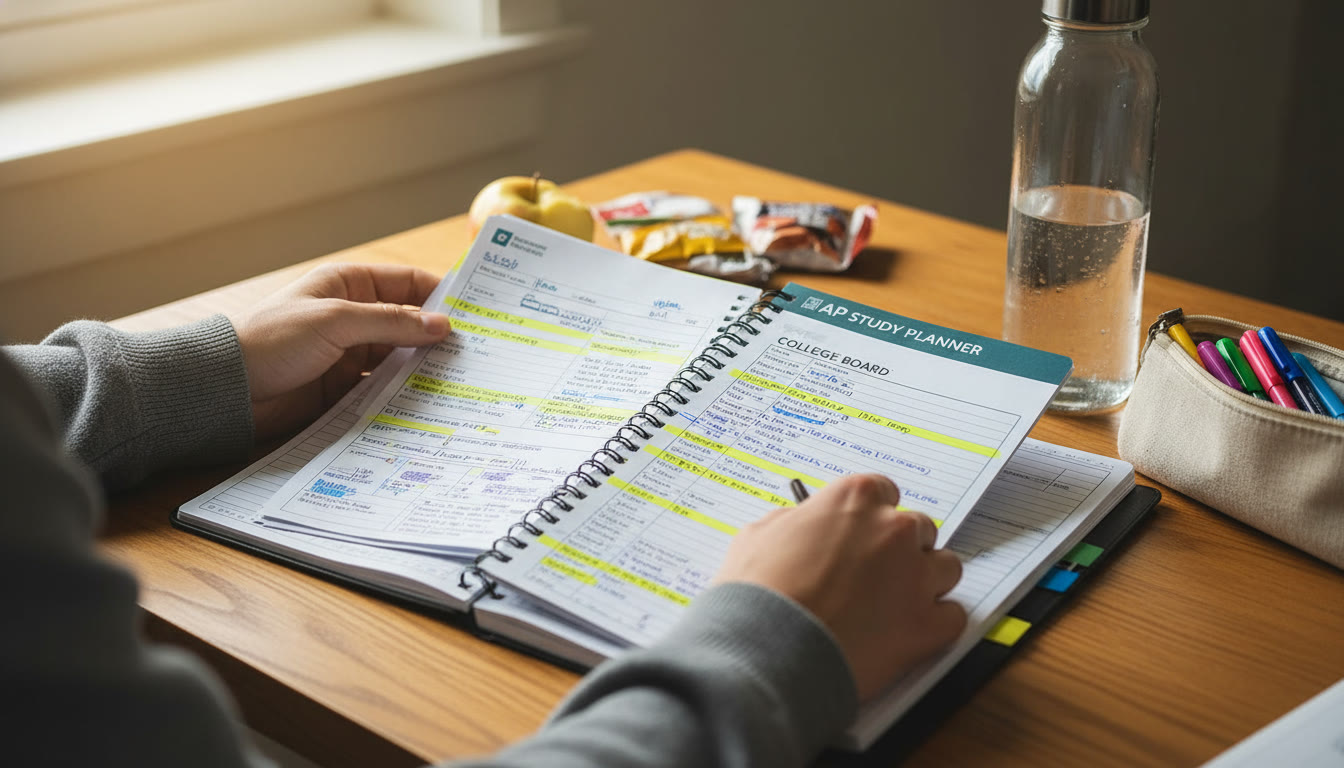Optics of Confidence: Why How You Carry Yourself Matters for AP Success
You know the feeling: you walk into the classroom, your heart is doing that little drum solo, and suddenly every pencil on every desk seems louder. Confidence—real, visible confidence—doesn’t come from a magic spell. It’s built from small habits you practice long before test day: the way you stand, how you breathe, the decisions you make about focus and preparation. For AP students, this is doubly important: you’re not only proving knowledge to yourself, you’re demonstrating it under timed, high-stakes conditions. The optics of confidence—how others read you and how you feel—can change your performance materially.
What ‘Optics’ Really Means for Students
Optics is a word we usually hear in media and leadership circles, but here it simply means “how you present.” In an AP environment, presentation matters in two main ways:
- Interpersonal optics — how teachers, graders, and peers read you (calm, poised, frazzled).
- Internal optics — how your body language affects your own mindset and cognitive performance.
Both are rooted in the same truth: body and mind are in constant conversation. Shift the conversation toward steadiness, and your thinking sharpens.

Body Language Basics Every AP Student Should Master
Before you dive into practice tests and content reviews, get familiar with a small toolkit of body-language moves that deliver outsized returns. These are simple, repeatable, and science-friendly.
1. The Power Posture
Stand or sit with a straight back, open chest, and shoulders relaxed but not slumped. This alignment reduces tension in the neck and allows deeper breathing—both of which improve cognitive function. Practice it during timed sections or while reviewing notes; the habit carries into the exam room.
2. Grounding Through Feet and Breath
When nerves rise, anchor yourself. Plant your feet flat on the floor and breathe slowly—inhale for four counts, hold two, exhale for six. This rhythm activates the parasympathetic system (the calm-down switch) and lowers heart rate. Use it between sections or when you read a tough question.
3. The Eyes-Forward Strategy
Eye contact isn’t just social—it’s attention management. When you catch your gaze wandering, intentionally bring it back to the task: the passage, the problem, the prompt. For long free-response prompts, break the text into visual chunks with your eyes rather than attempting to swallow it whole.
4. Micro-Movements for Focus
Small, deliberate movements—tapping a pen lightly, adjusting posture, or folding a corner of your scratch paper—can re-center attention without breaking flow. The key is intentionality: avoid fidgeting that disrupts thought; make it purposeful.
Focus Techniques That Maximize Study and Exam Performance
Confidence shows up when focus is steady. The following methods help build that steady attention span in study sessions and during the AP exam.
Pomodoro With a Purpose
Use focused intervals (25–50 minutes) followed by short breaks (5–10 minutes). During the interval, remove distractions: phone face-down, notifications off, browser tabs limited. During breaks, stand up, stretch, and use a breathing exercise to reset. Over time, these cycles train your brain to sustain concentration.
Task Pre-Orientation
Before starting a practice section, spend 60–90 seconds surveying the task: skim the structure, note timing, and set a micro-goal (e.g., “Complete the multiple-choice in 35 minutes, leaving 10 for review”). This reduces cognitive load when you begin and keeps you from getting derailed by surprises.
Active Reading: Mark, Paraphrase, Predict
Active reading tricks convert passive scanning into deliberate understanding. For passages, mark the thesis, underline evidence, paraphrase a sentence in the margin, and predict the author’s point before reading the next paragraph. For math, restate the question in your own words before solving.
Real-World Routines: Morning, Study Block, and Exam-Ready
Routines anchor confidence. Below are sample routines students can tailor to their schedules. These combine body-language cues, focus practices, and study structure.
Morning Routine (30–45 minutes)
- Hydrate and eat a light protein-rich snack.
- 5 minutes of grounding breathing and posture check (stand tall, shoulders back).
- Quick high-level review: 10–15 minutes of flashcards or a formula sheet.
- Positive visualization: 1–2 minutes imagining calm execution during a timed section.
Study Block (90–120 minutes)
- Pomodoro cycles: 45 minutes focus / 10 minutes break.
- Active practice: timed multiple-choice, then targeted review of mistakes.
- 1-on-1 check-in or reflection: jot two wins and two areas to polish.
Pre-Exam (30–60 minutes)
- Light warm-up questions—no heavy cramming.
- 5–7 minutes of posture and breath tuning: stand, inhale, visualize calm.
- Pack checklist: pencils, eraser, calculator if allowed, snacks, ID.
How Body Language Shapes Your Internal State (and Vice Versa)
There’s a two-way street here. Your posture can change your mood, and your mood can drag down your posture. The trick is to use one to influence the other intentionally.
Example: From Panic to Poise
Imagine hitting a tricky AP Physics question about lenses. Panic builds, shoulders hunch, and breath shortens—your brain goes into reactive mode. Reverse the loop: take a 30-second posture reset (sit upright, roll shoulders back), do a slow breath cycle, and then outline the problem on scratch paper. The physical reset lowers arousal and frees up working memory.
Expressing Confidence on Paper and in Speech
Confidence isn’t only visible in posture. When writing free-response answers, organize responses with clear structure headings, assertive topic sentences, and evidence laid out methodically. If you’re presenting or speaking in class, match your words with open gestures and measured pacing—both send the signal that you’re in control.
Quick Tools and Exercises You Can Do Anywhere
Use these bite-sized exercises when you need a fast confidence boost.
- Two-Minute Victory: For two minutes, list three recent study wins out loud. Celebrate them physically—a small smile, a breath, a stretch.
- Square Breathing: Inhale for 4, hold 4, exhale 4, hold 4. Repeat 3–5 times to reduce jitteriness.
- Focus Anchor: Choose a short phrase (e.g., “One step, one problem”) and repeat silently whenever attention drifts.
Data-Driven Habits: A Simple Table to Track Progress
Tracking small behavioral changes helps turn them into habits. Use a weekly tracker to record posture checks, Pomodoro sessions, and confidence notes. Below is a simple template you can copy into a notebook or digital planner.
| Day | Posture Checks (times) | Pomodoro Blocks | Timed Practice Completed | Mood/Confidence Rating (1–10) | Notes / Wins |
|---|---|---|---|---|---|
| Monday | 3 | 4 | MC Section (35 min) | 7 | Improved focus during last block |
| Tuesday | 2 | 3 | FRQ practice (50 min) | 6 | Need shorter breaks |
| Wednesday | 4 | 5 | Full practice test (timed) | 8 | More consistent breathing during test |
Common Pitfalls and How to Dodge Them
Even with the best intentions, students fall into predictable traps. Recognize them and use the countermoves below.
Pitfall: The All-Or-Nothing Mindset
Believing you must be perfectly prepared or you’re doomed creates performance anxiety. Counter: focus on incremental improvement. Use the table above to notice small gains; they compound.
Pitfall: Over-Reliance on Cramming
Cramming spikes stress and produces shallow recall. Counter: distributed practice plus short, confident review sessions the morning of a test—this maintains freshness without causing overload.
Pitfall: Mindless Fidgeting
Uncontrolled fidgeting scatters attention. Counter: convert the movement into micro-routines—intentional pen taps or a single stretch at break time—so motion supports focus instead of sabotaging it.
How Tutoring and Targeted Feedback Supercharge Confidence
One of the fastest ways to build exam-day optics is to get targeted, constructive feedback—and to practice the body-and-mind techniques under realistic conditions. Personalized tutoring gives students that advantage in three ways:
- 1-on-1 Guidance: Tutors can observe your live practice and suggest posture tweaks, pacing adjustments, and focus strategies tailored to your habits.
- Tailored Study Plans: A personalized plan balances content review with timed practice and mindset work so you don’t overfit to one kind of preparation.
- Data-Driven Insights: Expert tutors use performance data to highlight weak spots and celebrate gains—this builds confidence through evidence.
For students preparing for AP exams, Sparkl’s personalized tutoring offers these benefits naturally: expert tutors, tailored study plans, and AI-driven insights that track progress and highlight next steps. When coaching includes attention to posture, breathing, and test pacing, the results can be transformational: students don’t just know more—they perform more confidently.
Putting It Together: A Sample Week to Build Optics of Confidence
Below is a compact, actionable plan. It blends body-language practice, focused study, and reflective checkpoints so each week becomes a deliberate leap forward.
- Monday: 90-minute study block. Warm-up with posture/breathing; 45 minutes of AP multiple-choice practice; 15 minutes review; evening 10-minute reflection.
- Tuesday: Short content drills (60 minutes). Focus on weak formulas or vocab. End with 10 minutes of visualization.
- Wednesday: Full timed section (long). Apply posture checks every 20 minutes. Track mood rating.
- Thursday: Targeted tutoring session (or self-review). Ask for feedback on pacing and clarity in written responses. Use tutor suggestions to adjust study plan.
- Friday: Light practice and consolidation. Two Pomodoro cycles and a quick confidence journal: three things you did well this week.
- Weekend: Full mock exam one day; rest and light review the other day. Focus on recovery—sleep, food, and short walks.
Exam Day: Rituals That Deliver Calm and Clarity
On the day itself, rituals trump improvisation. Rituals are small, repeatable acts that cue your brain: you do them, and your brain says, “We’ve done this before, we’re fine.”
Pre-Exam Rituals
- Morning: light breakfast, hydration, 5–10 minutes of breathing and posture tuning.
- Before the test: slow walk to the room if possible; three intentional posture resets; a brief glance over your cheat-sheet summary (no cramming).
- During the test: use a focus anchor between questions, and perform a posture reset at least once every 20–30 minutes.
Stories From the Room: Short Student Vignettes
Stories stick. Here are two quick snapshots to illustrate the shift that small changes can create.
Case 1: From Slouched to Strategic
Emma, a junior, struggled with timed essays. She started a simple routine: posture check before each prompt and a one-sentence outline on scratch paper before writing. Within three weeks, her essay structure improved, and so did her calm. The graders noticed clarity; Emma noticed lower stress.
Case 2: Turning Micro-Nerves Into Focus
Jordan had test anxiety that triggered hand tremors. He taught himself two rituals: square breathing and a pen-tapping micro-movement when he needed to refocus. The tremors diminished, and his multiple-choice accuracy climbed because he could read longer without getting overwhelmed.
Final Notes: Your Confidence Is a Practice, Not a Gift
Confidence in the AP context is a learned skill. It’s composed of visible habits—posture, breathing, pacing—and mental frameworks—task orientation, distributed practice, deliberate reflection. The most effective students treat confidence like content: they study it, practice it, and measure it.
If you want to fast-track the process, consider pairing your study with tailored support. Sparkl’s personalized tutoring can help translate these body-and-mind techniques into your daily routine through 1-on-1 guidance, tailored study plans, and AI-driven insights that highlight progress and next steps. When preparation becomes both strategic and embodied, the optics of confidence follow naturally.
One Last Portable Checklist
- Posture check every 20–30 minutes.
- Two minutes of grounding breath before any timed section.
- Use Pomodoro cycles for study blocks.
- Keep a short weekly tracker (posture, Pomodoro, practice, mood).
- Get targeted feedback—practice under observation when possible.
Walk into your next AP class or exam room knowing that you’ve practiced more than content: you’ve practiced how to be calm, present, and deliberate. Those optics—what you show and what you feel—are the quiet advantage that turns preparation into performance. Breathe, align, focus, and let your preparation do the talking.



















No Comments
Leave a comment Cancel